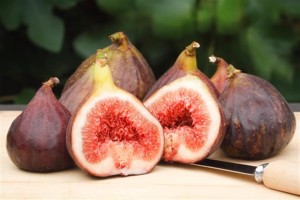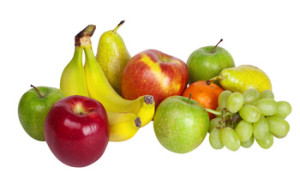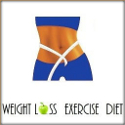-
Preventing Heart Disease: Fresh Fruit to the Rescue!
Wednesday, April 16th, 2025by Dr. Janet Brill, Registered Dietitian and Cardiovascular Nutritionist
Fabulous Figs and Other Fruit for Your Heart: What Eating Fruit Can Do for You
Sweet and delicious raw, dried, or as jam, figs are one of the plant kingdom’s brightest stars in terms of calcium and fiber content.
 However, what really labels figs as a bonafide heart attack prevention superfood is their extraordinary amount of carotenoids, most notably lycopene, lutein, and betacarotene.
However, what really labels figs as a bonafide heart attack prevention superfood is their extraordinary amount of carotenoids, most notably lycopene, lutein, and betacarotene.Few foods on earth are known to contain such an array of heart health-promoting antioxidants. Eating figs and other fruit is key to heart health.
Studies show that people who eat a diet rich in fruit are less likely to suffer a fatal heart attack.
Figs and other fruit are one of the eight key food groups that are part of my plan to reverse heart disease, or build good heart health to hopefully avoid heart troubles.
Other foods you should include in your heart-healthy diet are extra virgin olive oil, leafy greens, lentils and other legumes, salmon and other seafood, walnuts and flax seeds, oatmeal and other whole grains, and red wine.
(Dark chocolate is a bonus food in this plan. Yippee!)
Figs, like many of the fruit that Mother Nature has so generously provided us, are nutrient-dense, meaning you get a big nutritional bang for your calorie buck.
Fruit contains a good amount of fiber, vitamins, and potassium, plus an extraordinary array of potent plaque-fighting polyphenols. These sweet treats should be part of everyone’s heart-disease-fighting arsenal.
Eat a Variety of Fruits to Keep Your Heart Healthy
Daily intake of a variety of different types of fruit is good for the heart. Aim to mix-n-match your fruit for health. Try a Mediterranean-style fruit such as figs or pomegranate, a vitamin C-rich fruit such as kiwi, and don’t forget the other fruits such as apples or bananas.
Aim to mix-n-match your fruit for health. Try a Mediterranean-style fruit such as figs or pomegranate, a vitamin C-rich fruit such as kiwi, and don’t forget the other fruits such as apples or bananas. Consuming at least three fruits a day can boost your heart disease defense system by:
- Increasing your body’s antioxidant level. Fruit is a virtual antioxidant factory, housing a nice amount of flavonoids, carotenoids, and vitamin C.
- Immunizing “bad” LDL cholesterol against free radical attack.
- Protecting against endothelial dysfunction. A key early event in the process of atherosclerosis is when an abnormality in the functioning of the inner layer of the artery wall – the endothelium – arises, termed “endothelial dysfunction.”
- Lowering your blood pressure. Fruits – especially bananas, oranges, and prunes – are loaded with potassium. Potassium is a mineral superstar when it comes to helping you attain a healthy blood pressure reading.
- Helping you control your weight. Fiber-rich, low-calorie fruits and vegetables increase feelings of satiety, which helps with weight control. So as you fill up on those low-calorie, antioxidant-packed fruits and veggies, you’ll also watch your waistline go down – slowly but surely.
Here are a few of the ideas to help you get in your minimum of three servings of whole fruit a day:
- Make fresh fruit and whole grains standard breakfast fare. Add seasonal berries or dried fruit such as cranberries into your oatmeal (the heart-healthiest breakfast cereal). If you drink juice at breakfast, switch to eating a whole fruit – this way you get more fiber and flavonoids in
fewer calories – a bargain that both your heart and your waistline can appreciate!
- Add figs or other dried fruits like cranberries, apricots, or currants to your dark green leafy salad — a delicious, sweet addition to spruce up the salad as well as give you a feast of antioxidants, especially if you dress the salad with lemon juice and an olive oil vinaigrette.
- Try fruit for dessert. If you just can’t go to bed without a little something sweet, why not try some dried figs? And no, I’m not talking about a certain famous fig cookie, two of which give you a mere 1 gram of fiber (not to mention lots of added sugar, salt, and even some artery-clogging trans fat).
Compare that to the real thing — what Mother Nature intended for us to eat — two dried figs, which offer a whopping 5 grams of fiber, a huge cache of blood-pressure-lowering potassium (348 milligrams), and a nice dose of bone-building calcium, with 0 added sugar or fat. If it was good enough for Cleopatra, why not give it a try?
- Make fruit easily accessible. Place an eye-appealing bowl of assorted fruit smack dab in the center of high traffic areas in your house and be sure to grab a piece when you walk by. Substitute fruit for fat in baking recipes. Mashed bananas or prune puree work astonishingly well in baked goods. They add moistness with fiber and flavonoids – but without the fat.
If you’re not a baker, dried figs are a tasty addition to soups or legume dishes and add a hint of sweetness. You may be surprised at how some recipes truly come alive with the addition of this colorful and healthy class of superfoods. Many of the recipes in Prevent a Second Heart Attack feature fruit and are sure to please the palate.
Recipe: Chef Julie Korhumel’s Wild Rice Salad
If wild rice isn’t available, this salad can be made with 2 1/2 cups of another cooked whole grain, such as brown rice or wheat-berries.Serves 8.
2 1/2 cups of cooked wild rice (about 1 cup uncooked)
2/3 cup chopped dried figs
1/2 cup chopped flat-leaf parsley
1/3 cup chopped red bell pepper
1/4 cup slivered almonds, toasted
1/4 cup fresh lemon juice
2 tablespoons chopped red onion
2 tablespoons extra-virgin olive oil
1/4 teaspoon kosher salt
1/4 teaspoon freshly ground black pepperToss all ingredients together and serve cold.
NUTRITION per 1/2 cup serving:
Calories: 138
Fat: 5 g (0 g EPA, 0 g DHA, < 1 g ALA) Saturated Fat: 1 g Cholesterol: 0 mg Sodium: 40 mg Carbohydrate: 21 g Dietary Fiber: 3 g Sugars: 7 g Protein: 3 g(published April 15, 2014)
 Janet Brill, Ph.D., R.D., LDN, is a leading diet, nutrition, and fitness expert specializing in cardiovascular disease prevention. She is the author of Cholesterol Down: 10 Simple Steps to Lower Your Cholesterol in 4 Weeks – Without Prescription Drugs (Three Rivers Press, 2006), and Prevent a Second Heart Attack: 8 foods, 8 Weeks to Reverse Heart Disease (Three Rivers Press, Feb. 2011). To learn more about Dr. Janet, get delicious heart-healthy recipes, or buy her books, please visit DrJanet.com or PreventaSecondHeartAttack.com.
Janet Brill, Ph.D., R.D., LDN, is a leading diet, nutrition, and fitness expert specializing in cardiovascular disease prevention. She is the author of Cholesterol Down: 10 Simple Steps to Lower Your Cholesterol in 4 Weeks – Without Prescription Drugs (Three Rivers Press, 2006), and Prevent a Second Heart Attack: 8 foods, 8 Weeks to Reverse Heart Disease (Three Rivers Press, Feb. 2011). To learn more about Dr. Janet, get delicious heart-healthy recipes, or buy her books, please visit DrJanet.com or PreventaSecondHeartAttack.com.


